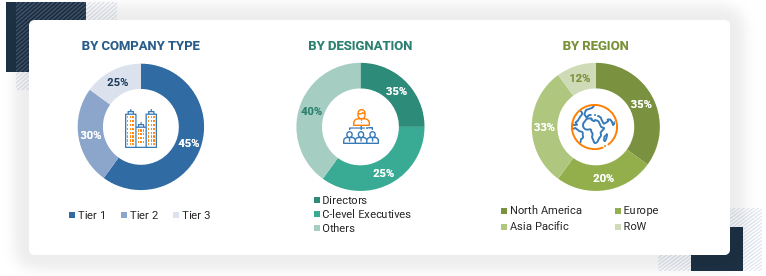The study involved major activities in estimating the current size of the Well Intervention market. Exhaustive secondary research was done to collect information on the peer and parent markets. The next step was to validate these findings, assumptions, and sizing with industry experts across the value chain through primary research. Both top-down and bottom-up approaches were employed to estimate the complete market size. Thereafter, market breakdown and data triangulation were used to estimate the market size of the segments and subsegments.
Secondary Research
This research study on the Well Intervention market involved the use of extensive secondary sources, directories, and databases, such as the Federal Energy Regulatory Commission (FERC), Occupational Safety and Health Administration (OSHA), Bureau of Safety and Environmental Enforcement (BSEE), Canada Energy Regulator (CER), Norwegian Offshore Directorate, North Sea Transition Authority (NSTA), National Offshore Petroleum Safety and Environmental Management Authority (NOPSEMA), and Saudi Arabian Standards Organization, to identify and collect information useful for a technical, market-oriented, and commercial study of the global Well Intervention market. The other secondary sources included annual reports, press releases & investor presentations of companies, white papers, certified publications, articles by recognized authors, manufacturer associations, trade directories, and databases.
Primary Research
Well intervention encompasses various operations aimed at enhancing or restoring production in wells, addressing issues like flow restrictions, reservoir changes, sand production, or mechanical failures. Costs escalate as offshore activities expand into deeper waters and encounter more complex conditions. Techniques like wireline units for light intervention and CT or HWO units for medium intervention offer cost-effective alternatives, particularly for live wells. Platform well intervention utilizes equipment brought onto the platform, while subsea intervention, although more costly, is mitigated by specialized vessels and innovative subsea systems. The industry trend favors cost reduction through dedicated intervention vessels and advanced subsea technologies.

To know about the assumptions considered for the study, download the pdf brochure
Market Size Estimation
Both top-down and bottom-up approaches were used to estimate and validate the total size of the Well Intervention market. These methods were also used extensively to estimate the size of various subsegments in the market. The research methodology used to estimate the market size includes the following:
Well Intervention Market Size: Top-Down Approach & Bottom-Up Approach
Data Triangulation
After arriving at the overall market size from the above estimation process, the total market has been split into several segments and subsegments. To complete the overall market engineering process and arrive at the exact statistics for all the segments and subsegments, data triangulation and market breakdown processes have been employed, wherever applicable. The data has been triangulated by studying various factors and trends from both the demand- and supply sides. Along with this, the market has been validated using both the top-down and bottom-up approaches.
Market Definition
At some point, oil and gas wells have to be maintained, repaired, or replaced to keep them operating as long as possible. Well intervention services achieve this. Well intervention refers to any remedial operation performed on oil or gas wells to restore or improve fluid production (oil and gas). It can be carried out during the well completion, production, or abandonment processes. It is performed due to flow restrictions in a well, changes in reservoir characteristics, sand production, mechanical failure, or to provide access to additional hydrocarbon reserves. Some common well intervention operations include slackline, coiled tubing, hydraulic workover, and wireline, but the well downhole applications may vary depending on a particular well, such as well surveillance and diagnostic, reservoir management techniques, re-entry drilling towards accessing new producing intervals, complete repair and abandonment, and well evaluation. Well intervention services might be performed onshore oil and gas fields or maybe done offshore.
Stakeholders
-
Consulting companies in the energy & power sector
-
Government & research organizations
-
Investment banks
-
National oil companies (NOCs)
-
Oil & gas field operators
-
Oilfield service companies
-
Power & energy associations
-
Drilling contractors
-
Well intervention service providers
-
Well intervention tools and equipment manufacturers
-
Drilling contractors
Report Objectives
-
To define, describe, and forecast the oil and gas pumps market based on type, pump type, application and region in terms of value
-
To define, describe, segment, and forecast the Well Intervention market, in terms of value and volume based on service, intervention type, well type, application, and region
-
To forecast the market size for five key regions: North America, South America, Europe, Asia Pacific, and Middle East & Africa, along with their key countries
-
To provide detailed information about the key drivers, restraints, opportunities, and challenges influencing the growth of the market
-
To strategically analyze the subsegments concerning individual growth trends, prospects, and contributions of each segment to the overall market size
-
To analyze market opportunities for stakeholders and the competitive landscape of the market
-
To strategically profile the key players and comprehensively analyze their market shares and core competencies
-
To analyze competitive developments, such as deals and agreements in the market



Daniel
Jun, 2022
Interested in the major factors influencing the growth and policies applied by the companies of the global well intervention market for the period of 2022-2030..